1 [Federal Register: September 27, 2005 (Volume 70, Number 186 ...
1 [Federal Register: September 27, 2005 (Volume 70, Number 186 ...
1 [Federal Register: September 27, 2005 (Volume 70, Number 186 ...
Create successful ePaper yourself
Turn your PDF publications into a flip-book with our unique Google optimized e-Paper software.
[<strong>Federal</strong> <strong>Register</strong>: <strong>September</strong> <strong>27</strong>, <strong>2005</strong> (<strong>Volume</strong> <strong>70</strong>, <strong>Number</strong> <strong>186</strong>)][Rules and Regulations][Page 56358-56361]From the <strong>Federal</strong> <strong>Register</strong> Online via GPO Access [wais.access.gpo.gov][DOCID:fr<strong>27</strong>se05-7]–––––––––––––––––––––––––––––––––––DEPARTMENT OF TRANSPORTATION<strong>Federal</strong> Aviation Administration14 CFR Part 39[Docket No. FAA-<strong>2005</strong>-20356; Directorate Identifier 2004-NM-115-AD; Amendment 39-14294;AD <strong>2005</strong>-20-01]RIN 2120-AA64Airworthiness Directives; Boeing Model 737-100, -200, -200C, -300, -400, and -500 SeriesAirplanesAGENCY: <strong>Federal</strong> Aviation Administration (FAA), Department of Transportation (DOT).ACTION: Final rule.–––––––––––––––––––––––––––––––––––SUMMARY: The FAA is adopting a new airworthiness directive (AD) for all Boeing Model 737-100, -200, -200C, -300, -400, and -500 series airplanes. This AD requires repetitive inspections of thestiffeners at left buttock line (LBL) and right buttock line (RBL) 6.15 for cracks; and replacement ofboth stiffeners with new, improved stiffeners if any stiffener is found cracked. This AD also allowsreplacement of both stiffeners at LBL and RBL 6.15 with new, improved stiffeners, which terminatesthe repetitive inspections. This AD is prompted by reports of cracks in the stiffeners at LBL and RBL6.15 on the rear spar of the wing center section. We are issuing this AD to detect and correct cracksin the stiffeners at LBL and RBL 6.15, which could result in damage to the keel beam structure andconsequently reduce the capability of the airplane to sustain flight loads.DATES: This AD becomes effective November 1, <strong>2005</strong>.The incorporation by reference of a certain publication listed in the AD is approved by theDirector of the <strong>Federal</strong> <strong>Register</strong> as of November 1, <strong>2005</strong>.ADDRESSES: You may examine the AD docket on the Internet at http://dms.dot.gov or in person atthe Docket Management Facility, U.S. Department of Transportation, 400 Seventh Street, SW.,Nassif Building, room PL-401, Washington, DC.Contact Boeing Commercial Airplanes, PO Box 3<strong>70</strong>7, Seattle, Washington 98124-2207, forservice information identified in this AD.FOR FURTHER INFORMATION CONTACT: Nancy Marsh, Aerospace Engineer, AirframeBranch, ANM-120S, FAA, Seattle Aircraft Certification Office, 1601 Lind Avenue, SW., Renton,Washington 98055-4056; telephone (425)917-6440; fax (425) 917-6590.1
Examining the DocketYou may examine the AD docket on the Internet at http://dms.dot.govor in person at the Docket Management Facility office between 9 a.m. and 5 p.m., Monday throughFriday, except <strong>Federal</strong> holidays. The Docket Management Facility office (telephone (800) 647-52<strong>27</strong>)is located on the plaza level of the Nassif Building at the street address stated in the ADDRESSESsection.DiscussionThe FAA issued a notice of proposed rulemaking (NPRM) to amend 14 CFR part 39 to includean AD that would apply to all Boeing Model 737-100, -200, -200C, -300, -400, and -500 seriesairplanes. That NPRM was published in the <strong>Federal</strong> <strong>Register</strong> on February 15, <strong>2005</strong> (<strong>70</strong> FR 7693). (Acorrection of the NPRM was published in the <strong>Federal</strong> <strong>Register</strong> on May 19, <strong>2005</strong> (<strong>70</strong> FR 28988).)That NPRM proposed to require repetitive inspections of the stiffeners at left buttock line (LBL) andright buttock line (RBL) 6.15 for cracks; and replacement of both stiffeners with new, improvedstiffeners if any stiffener is found cracked. That NPRM also proposed to allow replacement of bothstiffeners at LBL and RBL 6.15 with new, improved stiffeners, which would terminate the repetitiveinspections.CommentsWe provided the public the opportunity to participate in the development of this AD. We haveconsidered the comments that have been submitted on the proposed AD.Support for the Proposed ADTwo commenters support the proposed AD.Request To Use Operator Equivalent ProceduresOne commenter requests that we revise paragraph (h) of the proposed AD to allow the use ofFAA-approved, operator equivalent procedures for draining and gaining access to the center fueltanks. The commenter states that Parts II and III of Boeing Alert Service Bulletin 737-57A1269,Revision 1, dated <strong>September</strong> 16, 2004, contain work steps for de-fueling and purging the centertanks. The commenter further states that mandating how the fuel tanks are purged does not directlyaffect the means of correcting the unsafe condition addressed in the proposed AD.We agree that the procedures specified in Parts II and III are intended for gaining access to thecenter tanks. We also agree that using an equivalent procedure to gain access would not adverselyaffect the means of correcting the unsafe condition, which is to detect and correct cracks in thestiffeners at LBL and RBL 6.15. Therefore, we have revised the first sentence of paragraph (h) of thisAD to require accomplishing the applicable actions in Part IV through Part IX of the service bulletin.Request for Credit for Previous InspectionsOne commenter requests that inspections performed in accordance with Boeing All OperatorTelex (AOT) M-7200-01-00426, dated February 19, 2001, be considered acceptable for compliancewith the inspections specified in paragraph (g) of the proposed AD. The commenter states that bothBoeing AOT M-7200-01-00426 and Boeing Alert Service Bulletin 737-57A1269, Revision 1, dated<strong>September</strong> 16, 2004, provide instructions for doing a detailed inspection of the stiffeners at LBL andRBL 6.15 on the rear spar of the wing center section within the same compliance time.2
We agree that the detailed inspections specified in Boeing AOT M-7200-01-00426 areacceptable for compliance with the corresponding requirements of this AD. We have added a newparagraph (k) to this AD to give credit and re-lettered the subsequent paragraphs accordingly.Request To Use New Stiffeners of the Existing Type DesignTwo commenters request that we revise paragraph (h) of the proposed AD to add the option ofreplacing a cracked stiffener with a new stiffener of the existing type design (made from <strong>70</strong>75-T6511aluminum extrusion). One commenter states that since we have determined a repetitive inspectioninterval of 4,500 flight cycles provides an adequate level of safety for detecting cracks in the existingstiffeners, then replacement with new stiffeners of the existing type design should also provide anadequate level of safety if the repetitive inspections are continued. Although there is an ample supplyof new stiffeners of the existing type design available, both commenters are concerned that there is aninsufficient supply of new, improved stiffeners (made from 2024-T351 aluminum alloy plate) tocomply with the proposed replacements.We do not agree. The manufacturer has confirmed that there is a sufficient supply of new,improved stiffeners available to comply with this AD. Therefore, no change to this AD is necessaryin this regard.Request To Replace a Stiffener, Only if CrackedTwo commenters request that we revise paragraph (h) of the proposed AD to state that, if onlyone of the two stiffeners is found cracked, operators would be required to replace only the crackedstiffener instead of both stiffeners. As justification, the first commenter states that it frequently findsonly one cracked stiffener during inspections of the stiffeners at LBL and RBL 6.15. Bothcommenters believe that the proposed AD should allow the option of replacing only the crackedstiffener provided that the repetitive inspections for cracking are continued until both stiffeners areeventually replaced. The second commenter supports this change because replacing both stiffenersrequires additional labor and material. The commenter also states that the aggressive initial inspectionthreshold will force operators to inspect affected airplanes outside of a heavy maintenance visit. Thecommenter asserts that the additional impact of replacing both stiffeners will strain availableresources.We do not agree because the new, improved stiffeners are much more rigid than the stiffeners ofthe existing type design. Replacing only one of the two stiffeners will lead to changes in the loadingof the structure and premature fatigue of the new, improved stiffener. However, we acknowledge thatreplacing a cracked stiffener with a new stiffener of the existing type design will not adversely affectthe relative stiffness of the two keel beam stiffeners, since they would be the same type design. Ifservice information containing repair instructions and subsequent inspection requirements forreplacing a cracked stiffener with a new stiffener of the existing type design is developed, under theprovisions of paragraph (l) of this AD, we may consider requests for approval of an AMOC.Sufficient data must be submitted to substantiate that such a design change would provide anacceptable level of safety. Therefore, no change to this AD is necessary in this regard.Request To Allow Temporary RepairsThree commenters request that we revise the proposed AD to allow operators to make temporaryrepairs until cracked stiffeners can be replaced. One commenter suggests adding an interim repairplan to the proposed AD to give operators time to schedule the terminating action (replacement ofcracked stiffeners with new, improved stiffeners). The commenter proposes that an interim repairplan could consist of stop-drilling small cracks where possible and reducing the repetitive inspectionintervals to monitor crack growth, until the terminating action could be accomplished. The3
commenter is concerned it will not be able to comply with the requirements of the proposed ADbecause of the short initial inspection threshold and number of affected airplanes in its fleet.The second commenter states that repairs done in accordance with Boeing AOT M-7200-01-00426, dated February 19, 2001, and Repair Sketch LOR-760 will take less time than replacement ofthe stiffeners, especially since most of its affected airplanes will be inspected outside of a heavymaintenance visit. The third commenter asks if we would consider the two temporary repairs, whichdo not require access into the center tank, as an AMOC to the proposed AD.We partially agree. The FAA is working with the manufacturer to establish appropriateinspection and replacement requirements for this interim repair. Once this evaluation is concluded wemay, under the provisions of paragraph (l) of this AD, we approve the subject interim repairs as anAMOC. We do not consider that delaying this final rule is warranted.Request To Revise Compliance TimeOne commenter requests that we extend the compliance time of the initial inspection, from 180days to 15 months for airplanes that have accumulated less than 30,000 total flight cycles, to allowaffected operators to perform the inspection during a regularly scheduled maintenance interval. Theproposed AD reported that cracked stiffeners were found on two airplanes with over 40,000 totalflight cycles and on a third airplane with just over 20,000 total flight cycles. The commenter believesthat the data are not consistent enough to warrant a short compliance time for airplanes that haveaccumulated fewer than 40,000 total flight cycles. To comply with the proposed AD, the operatorstates that it would have to inspect more than 1 airplane per week, since the proposed AD affects themajority of its fleet. The operator also states that its operations would be negatively impacted ifseveral of its airplanes required the terminating action, estimated at 250 work hours.We do not agree with the commenter's request. The commenter provides no technicaljustification for revising this inspection interval. Furthermore, since issuing the proposed AD, wehave received numerous additional reports of cracked stiffeners. Eight of those reports includedairplanes that have accumulated fewer than 30,000 total flight cycles. We have determined that thecompliance time, as proposed, represents the maximum interval of time allowable for the affectedairplanes to continue to operate safely before the inspection is accomplished.Request To Revise ''Cost of Compliance''One commenter estimates that the proposed inspection would take about 4 work hours, not 1work hour as we specified in the proposed AD. We infer that the commenter would like us to revisethe ''Cost of Compliance'' section.We do not agree, since the commenter has not provided justification for the increase in workhours. Our cost estimate is based on information that the manufacturer has provided to us, and wepoint out that the cost impact figures discussed in AD rulemaking actions represent only the timenecessary to perform the specific actions actually required by the AD. These figures typically do notinclude incidental costs, such as the time required to gain access and close up, planning time, or timenecessitated by other administrative actions. Therefore no change to this AD is necessary in thisregard.Explanation of Changes Made to This ADWe have simplified paragraph (h) of this AD by referring to the ''Alternative Methods ofCompliance (AMOCs)'' paragraph of this AD for repair methods. Also, we have revised the''Alternative Methods of Compliance (AMOCs)'' paragraph in this AD to clarify the delegationauthority for Authorized Representatives for the Boeing Commercial Airplanes Delegation OptionAuthorization.4
ConclusionWe have carefully reviewed the available data, including the comments that have beensubmitted, and determined that air safety and the public interest require adopting the AD with thechanges described previously. We have determined that these changes will neither increase theeconomic burden on any operator nor increase the scope of the AD.Costs of ComplianceThis AD affects about 3,132 airplanes worldwide. The following table provides the estimatedcosts, at an average labor rate of $65 per hour, for U.S. operators to comply with this AD.ActionInspection, perinspection cycleWork Partshours1 None $65, perinspection cycleESTIMATED COSTSCost per <strong>Number</strong> of U.S.-airplane registered airplanesFleet cost1,384 $89,960, perinspection cycle.Authority for This RulemakingTitle 49 of the United States Code specifies the FAA's authority to issue rules on aviation safety.Subtitle I, Section 106, describes the authority of the FAA Administrator. Subtitle VII, AviationPrograms, describes in more detail the scope of the Agency's authority.We are issuing this rulemaking under the authority described in Subtitle VII, Part A, Subpart III,Section 44<strong>70</strong>1, ''General requirements.'' Under that section, Congress charges the FAA withpromoting safe flight of civil aircraft in air commerce by prescribing regulations for practices,methods, and procedures the Administrator finds necessary for safety in air commerce. Thisregulation is within the scope of that authority because it addresses an unsafe condition that is likelyto exist or develop on products identified in this rulemaking action.Regulatory FindingsWe have determined that this AD will not have federalism implications under Executive Order13132. This AD will not have a substantial direct effect on the States, on the relationship between thenational government and the States, or on the distribution of power and responsibilities among thevarious levels of government.For the reasons discussed above, I certify that this AD:(1) Is not a ''significant regulatory action'' under Executive Order 12866;(2) Is not a ''significant rule'' under DOT Regulatory Policies and Procedures (44 FR 11034,February 26, 1979); and(3) Will not have a significant economic impact, positive or negative, on a substantial number ofsmall entities under the criteria of the Regulatory Flexibility Act.We prepared a regulatory evaluation of the estimated costs to comply with this AD. See theADDRESSES section for a location to examine the regulatory evaluation.List of Subjects in 14 CFR Part 39Air transportation, Aircraft, Aviation safety, Incorporation by reference, Safety.5
Adoption of the AmendmentAccordingly, under the authority delegated to me by the Administrator, the FAA amends 14 CFR part39 as follows:PART 39–AIRWORTHINESS DIRECTIVES1. The authority citation for part 39 continues to read as follows:Authority: 49 U.S.C. 106(g), 40113, 44<strong>70</strong>1.§ 39.13 [Amended]2. The FAA amends § 39.13 by adding the following new airworthiness directive (AD):6
AIRWORTHINESS DIRECTIVEAircraft Certification ServiceWashington, DCWe post ADs on the internet at www.faa.gov/aircraft/safety/alerts/U.S. Departmentof Transportation<strong>Federal</strong> AviationAdministrationThe following Airworthiness Directive issued by the <strong>Federal</strong> Aviation Administration in accordance with the provisions of Title 14 of the Code of <strong>Federal</strong> Regulations (14 CFR) part 39,applies to an aircraft model of which our records indicate you may be the registered owner. Airworthiness Directives affect aviation safety and are regulations which require immediateattention. You are cautioned that no person may operate an aircraft to which an Airworthiness Directive applies, except in accordance with the requirements of the AirworthinessDirective (reference 14 CFR part 39, subpart 39.3).<strong>2005</strong>-20-01 Boeing: Amendment 39-14294. Docket No. FAA-<strong>2005</strong>-20356; Directorate Identifier2004-NM-115-AD.Effective Date(a) This AD becomes effective November 1, <strong>2005</strong>.Affected ADs(b) None.Applicability(c) This AD applies to all Boeing Model 737-100, -200, -200C, -300, -400, and -500 seriesairplanes, certificated in any category.Unsafe Condition(d) This AD was prompted by cracks in the stiffeners at left buttock line (LBL) and right buttockline (RBL) 6.15 on the rear spar of the wing center section. We are issuing this AD to detect andcorrect cracks in the stiffeners at LBL and RBL 6.15, which could result in damage to the keel beamstructure and consequently reduce the capability of the airplane to sustain flight loads.Compliance(e) You are responsible for having the actions required by this AD performed within thecompliance times specified, unless the actions have already been done.Service Bulletin Reference(f) The term ''service bulletin,'' as used in this AD, means the Accomplishment Instructions ofBoeing Alert Service Bulletin 737-57A1269, Revision 1, dated <strong>September</strong> 16, 2004.Initial and Repetitive Inspections(g) Before accumulating 15,000 total flight cycles, or within 180 days after the effective date ofthis AD, whichever occurs later: Do a detailed inspection of the stiffeners at LBL and RBL 6.15 forcracks, in accordance with Part I of the service bulletin. Thereafter at intervals not to exceed 4,5007
flight cycles, repeat the detailed inspection until the stiffeners at LBL and RBL 6.15 have beenreplaced with new, improved stiffeners, in accordance with paragraph (h) or (i) of this AD.Note 1: For the purposes of this AD, a detailed inspection is: ''An intensive examination of aspecific item, installation, or assembly to detect damage, failure, or irregularity. Available lighting isnormally supplemented with a direct source of good lighting at an intensity deemed appropriate.Inspection aids such as mirror, magnifying lenses, etc., may be necessary. Surface cleaning andelaborate procedures may be required.''Replacement of Cracked Stiffeners(h) If any crack is found during any inspection required by this AD, before further flight, replaceboth stiffeners with new, improved stiffeners by doing all of the applicable actions in Part IV throughPart IX, as applicable, of the service bulletin; except where the service bulletin specifies to contactBoeing for appropriate action: Before further flight, repair using a method approved in accordancewith the procedures specified in paragraph (l) of this AD. Accomplishing the replacement terminatesthe repetitive inspections required by paragraph (g) of this AD.Optional Terminating Action(i) Replacement of both stiffeners at LBL and RBL 6.15 with new, improved stiffeners inaccordance with paragraph (h) of this AD terminates the repetitive inspections required by this AD.Credit for Previous Service Bulletin(j) The actions done before the effective date of this AD in accordance with Boeing Alert ServiceBulletin 737-57A1269, dated December 4, 2003, are acceptable for compliance with thecorresponding actions required by this AD.Credit for Previous Inspections(k) Inspections done before the effective date of this AD in accordance with Boeing All OperatorTelex M-7200-01-00426, dated February 19, 2001, are acceptable for compliance with therequirements of paragraph (g) of this AD.Alternative Methods of Compliance (AMOCs)(l)(1) The Manager, Seattle Aircraft Certification Office (ACO), FAA, has the authority toapprove AMOCs for this AD, if requested in accordance with the procedures found in 14 CFR 39.19.(2) An AMOC that provides an acceptable level of safety may be used for any repair required bythis AD, if it is approved by an Authorized Representative for the Boeing Commercial AirplanesDelegation Option Authorization Organization who has been authorized by the Manager, SeattleACO, to make those findings. For a repair method to be approved, the repair must meet thecertification basis of the airplane, and the approval must specifically refer to this AD.Material Incorporated by Reference(m) You must use Boeing Alert Service Bulletin 737-57A1269, Revision 1, dated <strong>September</strong> 16,2004, to perform the actions that are required by this AD, unless the AD specifies otherwise. TheDirector of the <strong>Federal</strong> <strong>Register</strong> approved the incorporation by reference of this document in8
accordance with 5 U.S.C. 552(a) and 1 CFR part 51. Contact Boeing Commercial Airplanes, P.O.Box 3<strong>70</strong>7, Seattle, Washington 98124-2207, for a copy of this service information. You may reviewcopies at the Docket Management Facility, U.S. Department of Transportation, 400 Seventh Street,SW., room PL-401, Nassif Building, Washington, DC; on the Internet at http://dms.dot.gov; or at theNational Archives and Records Administration (NARA). For information on the availability of thismaterial at the NARA, call (202) 741-6030, or go to http://www.archives.gov/federal-register/cfr/ibrlocations.html.Issued in Renton, Washington, on <strong>September</strong> 16, <strong>2005</strong>.Ali Bahrami,Manager, Transport Airplane Directorate, Aircraft Certification Service.[FR Doc. 05-19144 Filed 9-26-05; 8:45 am]BILLING CODE 4910-13-P9



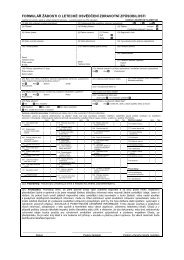
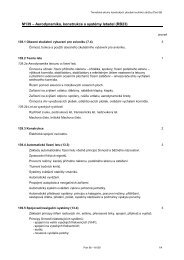
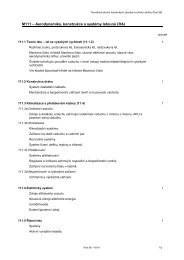
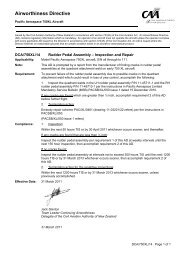
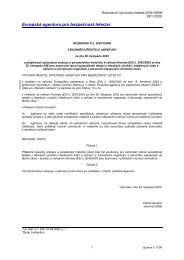
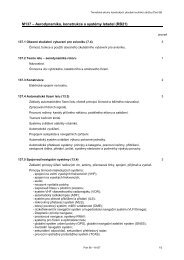
![AD 2010-0014 [PAD 09-006] Eurocopter ...](https://img.yumpu.com/50958012/1/184x260/ad-2010-0014-pad-09-006-eurocopter-.jpg?quality=85)
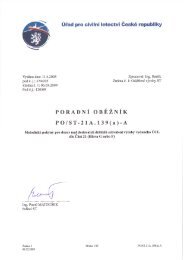
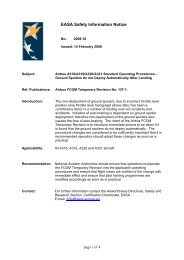
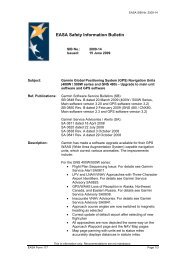
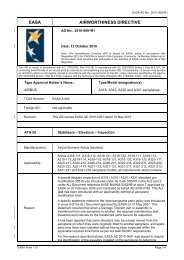
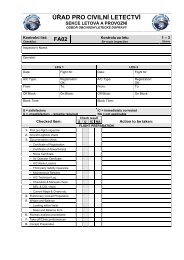
![1 [Federal Register: April 7, 2005 (Volume 70, Number 66)] [Rules ...](https://img.yumpu.com/49722490/1/190x245/1-federal-register-april-7-2005-volume-70-number-66-rules-.jpg?quality=85)
